Lifestyle
Looking to vacation on the California coast? Marin County just made it harder
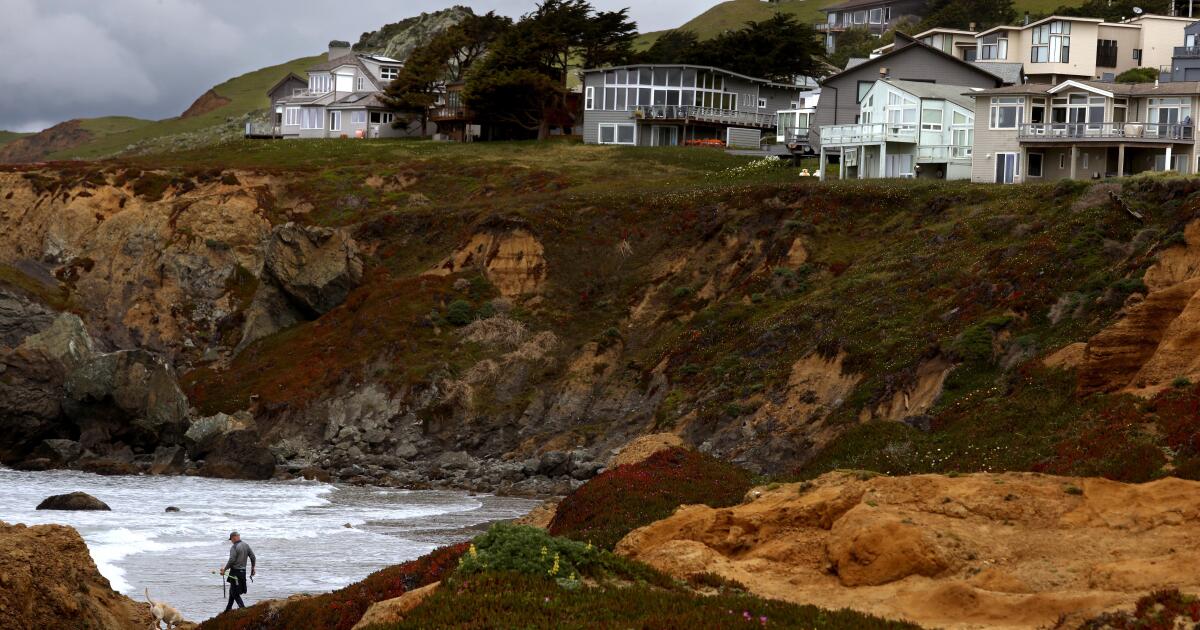
A stay in Brian Maggi’s house, per the Airbnb listing, is what coastal California dreams are made of.
“Bathed in natural sunlight,” it reads, you can “enjoy unobstructed panoramic views of the ocean and Point Reyes.” You can bring your dog. Walk to the sand. Savor “the perfect getaway” in the 1928 “BoHo surf shack.”
The little house in Dillon Beach, a remote town in western Marin County, is a second home for Maggi, a software designer who lives full time in Livermore, a hundred miles southeast.
He and his wife stay here a few weekends a month: Enough time to befriend neighbors and know the gossip, like who put in a new hot tub and who moved here to please a girlfriend despite hating the foggy weather.
“We’re not full-time residents,” Maggi said, “but we’re not absentee owners.”
“We’re really fortunate, and I get it,” Brian Maggi says of owning a second home in Dillon Beach. But he says cracking down on short-term rentals hasn’t made houses more affordable.
When Maggi is not using the house, he rents it on Airbnb for about $300 a night.
That’s a pretty common practice in Dillon Beach where, according to county estimates, a whopping 84% of the town’s 408 housing units are second homes and 31% are used as licensed short-term rentals.
Are those vacation rentals ruining California’s rugged little beach towns? Or are they opening up the coast to people who can’t afford to live there? Depends who you ask.
In Marin County, on the northern end of the San Francisco Bay, short-term rentals have become a lightning rod amid an affordable housing shortage in one of the most expensive — and beautiful — places in California.
This month, the Marin County Board of Supervisors approved a hard cap on the number of short-term rentals it will allow in unincorporated places, including the bucolic towns hugging iconic Highway 1 and the Point Reyes National Seashore.
The ordinance imposes a cap of 1,281 short-term rentals for unincorporated Marin County, where there were 923 licensed as of January.
The county has placed specific limits for 18 coastal communities, most of which will be allowed no more than the existing number of short-term rentals — while some will have to reduce their numbers. The exception is Dillon Beach, a historic vacation town where the short-term rental market will be allowed to significantly grow.

Dillon Beach homeowner Paul Martinez walks home after surfing. “Rent it responsibly,” Martinez says about owners renting out their houses when they are not in town.

Mounted surfboards add to the charm of this colorful home in Dillon Beach.
In Point Reyes Station, population 383, there are 32 short-term rentals, according to the county. Under the new rules, 26 will be allowed. In Stinson Beach, the cap will allow the amount of rentals that currently exist: 192.
In Dillon Beach, vacation rentals will be allowed to grow 63%, from 125 to 204. The town has no school and the only businesses are a resort and its general store, which supervisors noted make for a different kind of community than many of the other towns dotting the Marin coastline.
County officials said they expect the number of existing short-term rentals to shrink through attrition. Current license holders will have to reapply and adhere to stricter regulations, which can include expensive septic upgrades. The new rules allow just one short-term rental property per operator, and licenses will not transfer to new owners if a property sells.
Debate over the issue has raised questions not just about limited housing in Marin, but also about whether Airbnbs have become a critical means of providing public beach access — a right enshrined in the California Coastal Act — in seaside towns with few hotel rooms.
“Please do not codify this anti-visitor, exclusionary behavior. Do not turn a region dense in coastal public recreational lands into an exclusionary playground that only the elite can access,” Inverness resident Rachel Dinno Taylor, founder of the West Marin Access Coalition, a citizens group that fought the measure, said in a speech last month before the California Coastal Commission.
The Coastal Commission regulates development in the Coastal Zone — which is generally the first 1,000 yards from the shoreline but extends a few miles inland in some areas — and increasingly is weighing in on local efforts to limit short-term rentals.

If it weren’t for vacationers — who fill the village with laughter and kids and wagons and dogs — Dillon Beach would be dead most days, residents say.
Since 1992, the Coastal Commission has considered at least 47 short-term rental ordinances. It has approved all but four, including Marin County’s new ordinance.
“Vacation rentals can provide important public access to the coast, especially where hotels are scarce. But without thoughtful guidelines, they can also have unintended impacts on local housing availability,” Kate Huckelbridge, executive director of the Coastal Commission, said in a statement to The Times. “We think Marin County achieved the right balance for their unique and world-famous coastline.”
The West Marin Access Coalition, many of whose members rent out their homes and so have a financial stake in the debate, argued the county did not have enough data to prove short-term rentals directly affect housing availability. Many residents rely upon income generated by their rentals to afford staying in their homes, Sean Callagy, a member of the coalition, said in an email.
The county’s new policy, he wrote, will “create hardships for low- and middle-income residents, worsen housing insecurity and deny visitors access to the coast.”
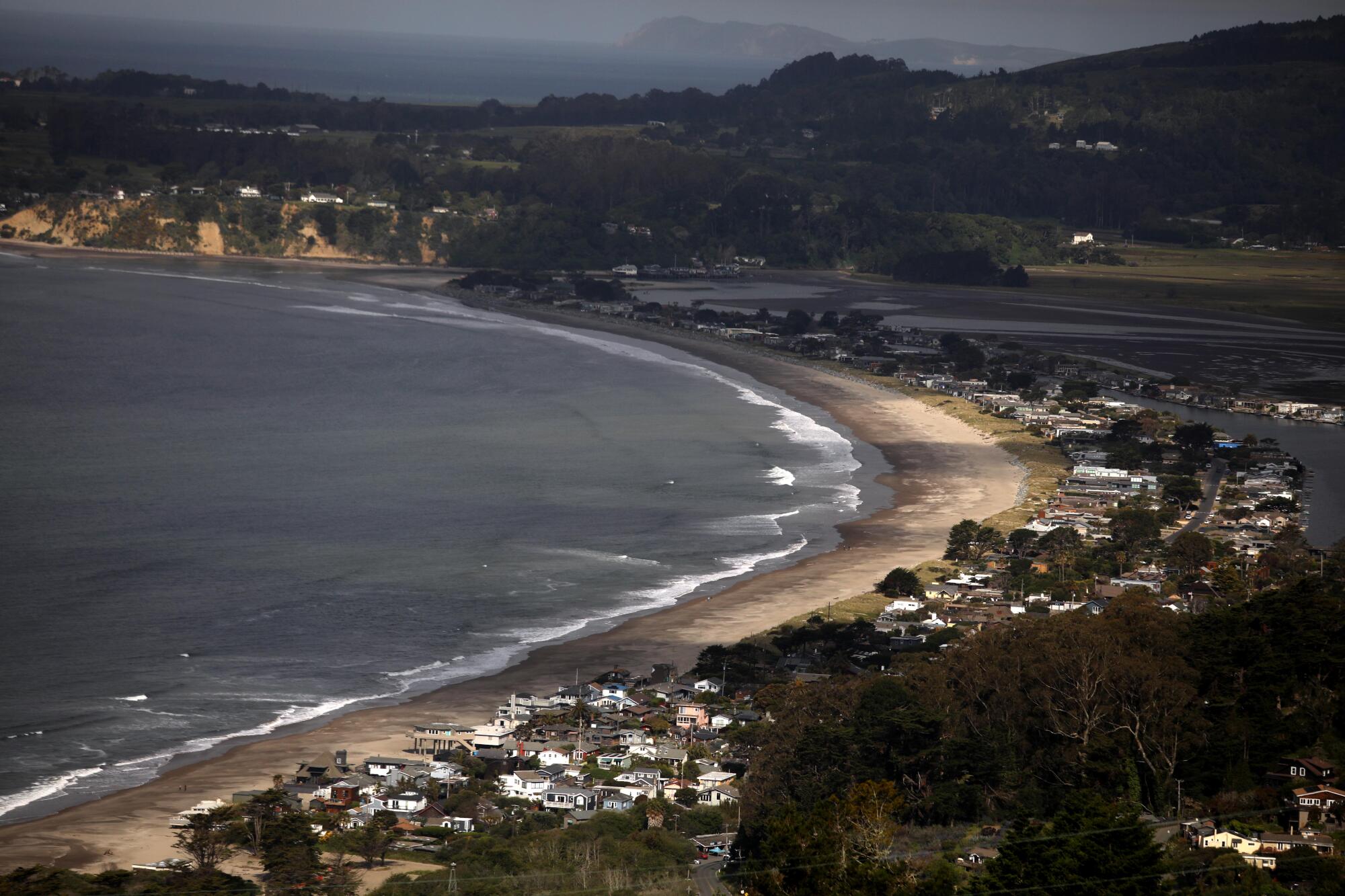
An aerial view of Stinson Beach in Marin County.
For years, high-demand destinations across California — including Los Angeles city and county, Palm Springs, Malibu, Ojai and San Francisco — have tried to rein in rental platforms such as Airbnb and Vrbo, citing the need to prevent housing from being converted into de facto hotel rooms .
In Marin County, the explosive growth in short-term rentals has been particularly divisive in smaller towns. There, the number of full-time residents is dwindling while millionaires’ second — and third — homes, many of which are used as seasonal rentals, sit empty much of the year.
That’s a cruel paradox when there are not enough affordable homes for people who work in those communities, proponents of the cap say.
In unincorporated Marin County, the median sales price of a single-family home rose 98% from 2013 to 2021, to $1.91 million, according to a countywide housing plan adopted last year.
“Housing affordability and housing supply were really the driving factor in why we’re addressing short-term rentals right now,” said Sarah Jones, director of the Marin County Community Development Agency. “There’s not housing being built. And the housing that’s available, people are just seeing that it’s more profitable and easier to use it as a short-term rental than to rent it out long term.”
Although Marin County has much open space, it has little room to expand housing. Roughly 85% of its land, including the Point Reyes National Seashore and the Golden Gate National Recreation Area, is public space or agricultural land protected from development.
Marin County Supervisor Dennis Rodoni, who represents the scenic West Marin towns where vacation rentals are most heavily concentrated, said they have transformed “tiny communities where even losing a few homes is a big deal.”
“Our volunteer fire departments are losing volunteers,” he said. “Our schoolteachers, we’re having a hard time locating them in the community; they have to commute long distances.”

Visitors stroll through downtown Stinson Beach along Highway 1 in West Marin County.
The elementary school in Stinson Beach, he noted, is “having a hard time keeping its doors open” because so few children now live there. The town’s population, according to census data, plunged 38% from 2016 to 2022, to 371. In 2022, there were no children younger than 15.
According to county estimates, 27% of housing units in Stinson Beach are used as short-term rentals — many of which are in the gated neighborhood of Seadrift, a flood-prone sand spit.
The town has “become like Martha’s Vineyard on the West Coast,” said August Temer, co-owner of Breakers Cafe on Highway 1 in Stinson Beach. “It’s not people’s primary residence.”
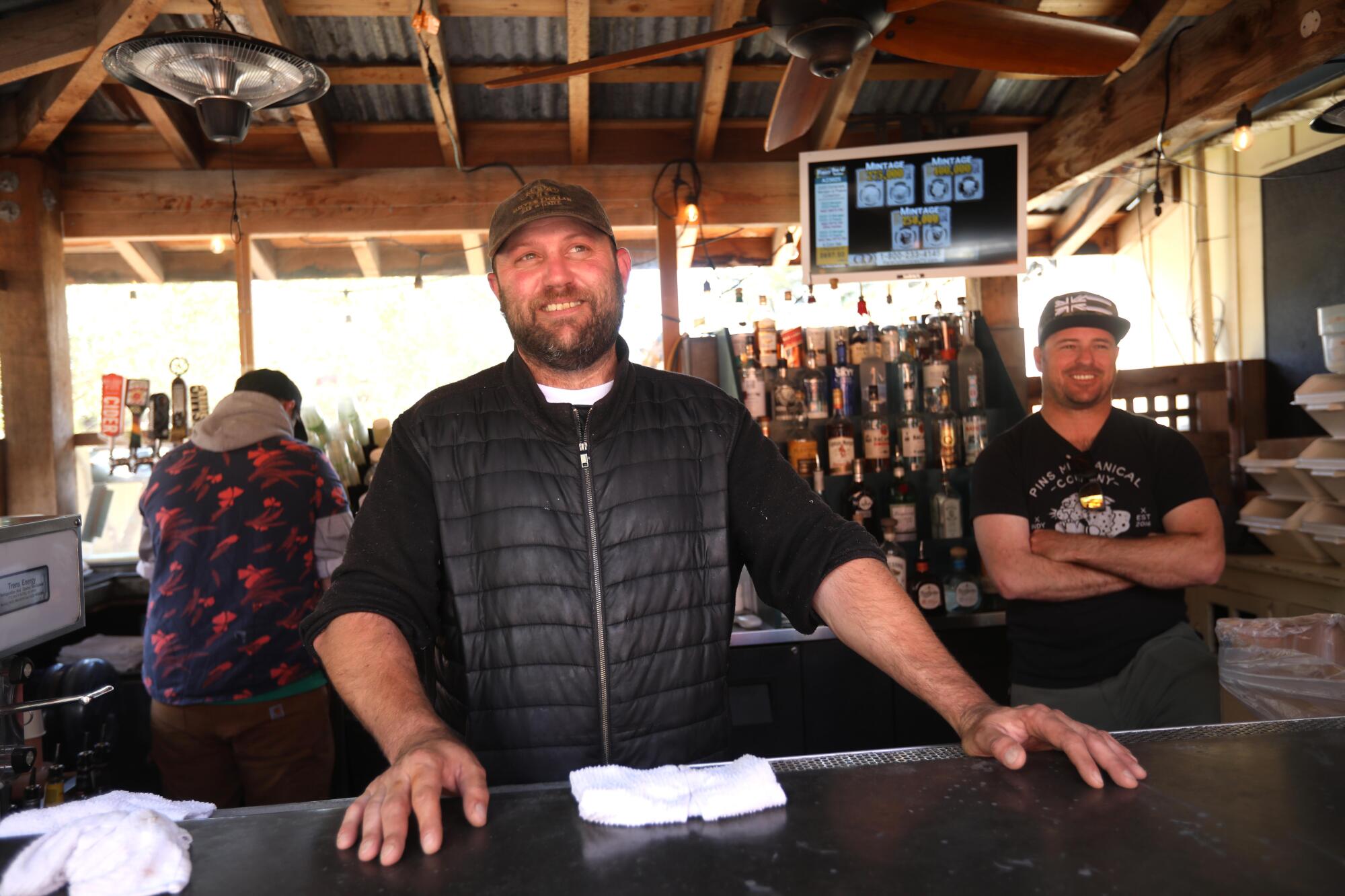
August Temer, center, co-owner of Breakers Cafe in Stinson Beach, says as a business owner he likes Airbnbs and the tourists they bring. But it’s sad, he says, that his employees can’t afford to live in town.
Standing behind the outdoor bar on a windy afternoon last month, Temer, a 45-year-old who grew up in Stinson Beach, said that as a business owner he likes Airbnbs and the money-spending tourists they bring in. But it’s sad, he said, that none of his employees can afford to live in town and must commute — which makes it difficult to keep workers.
Mac Bonn, the general manager, said he drives 45 minutes “over the hill,” traversing a winding mountain road, to his home in Fairfax.
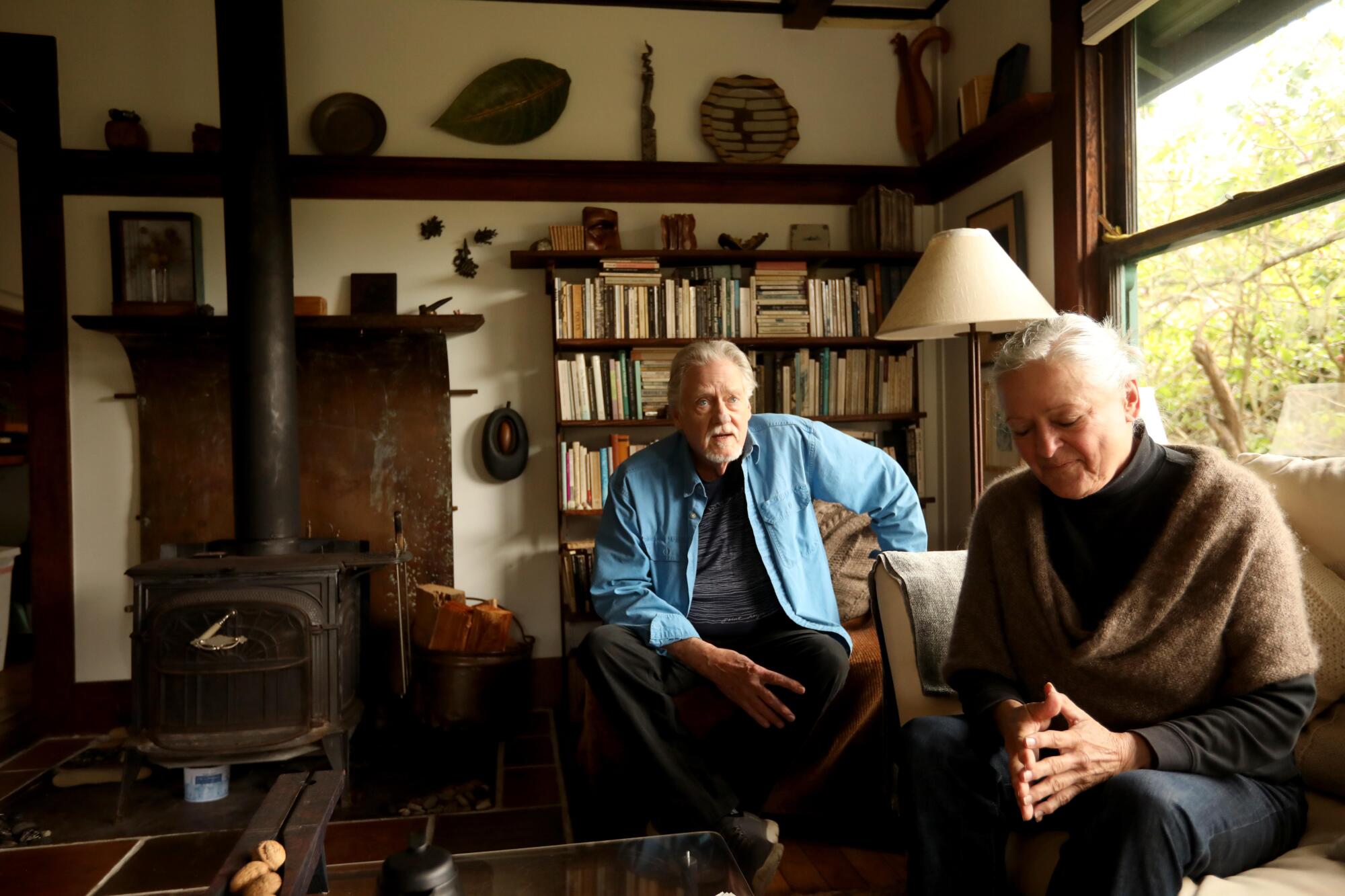
“We used to know this as very much a vibrant neighborhood,” says Bruce Bowser, seated with his wife, Marlie de Swart. “A lot if it’s thinned out. A lot of people are older and have passed or moved on.”
In nearby Bolinas, artist Marlie de Swart and husband Bruce Bowser welcomed the new rules, telling the Coastal Commission in a letter that their town “is being changed from a characteristic village to a vacation rental suburb.”
The county ordinance limits the number of short-term rentals in Bolinas to 54. There are now 63.
The septuagenarian couple bought their century-old house with picture windows and redwood ceilings in downtown Bolinas in 1992 for about $230,000. They were stunned when a nearby house recently sold for nearly $3 million after its owner died.
Bolinas is so famously opposed to outsiders that, for years, a vigilante band called the Bolinas Border Patrol cut down road signs on Highway 1 that pointed the way into town.
Alas, Google Maps directed tourists to Bolinas. And the Airbnbs kept them there.
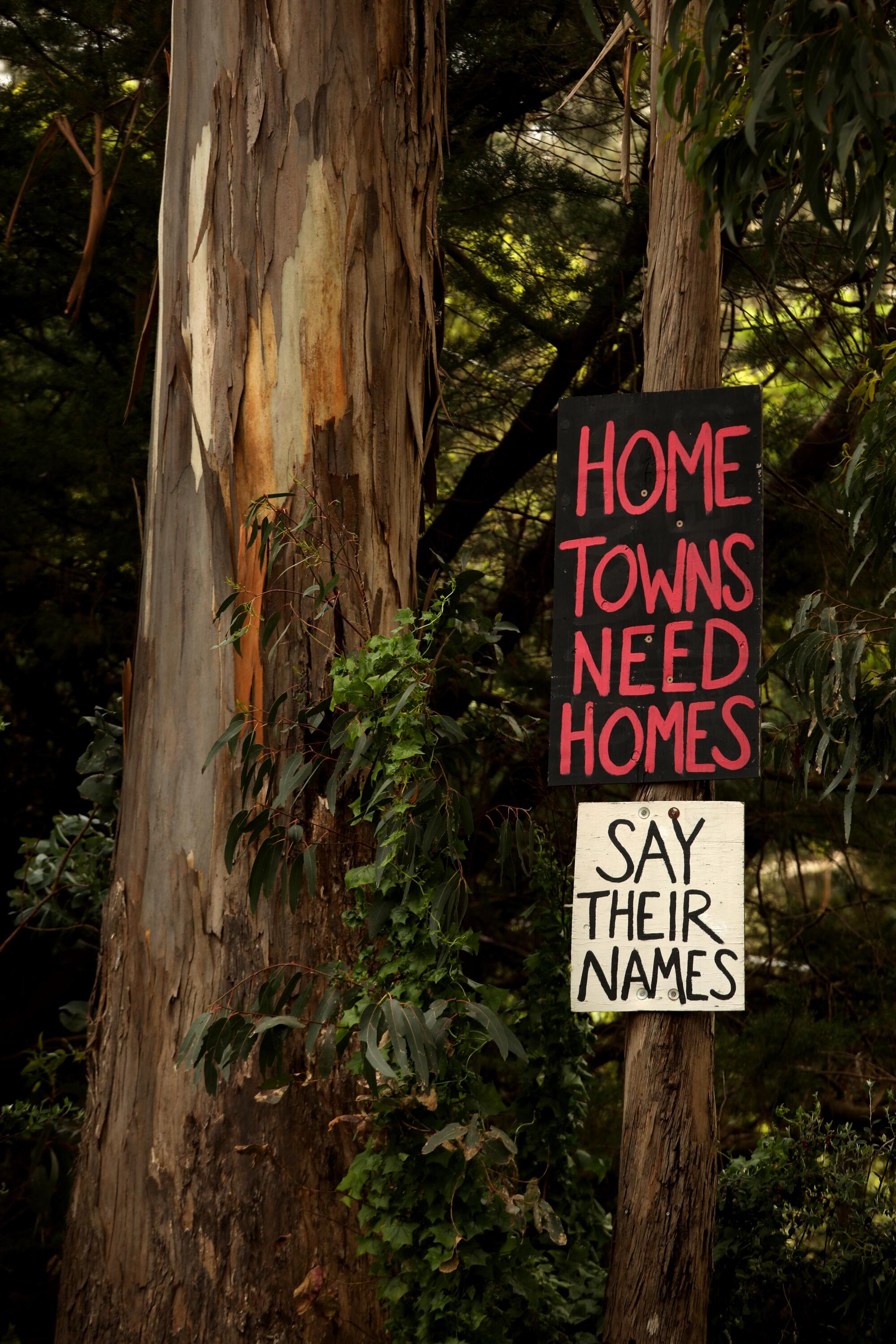
Bolinas residents say neighbors have been replaced by short-term guests and empty second homes, making the town feel more like a vacation rental suburb than a cozy hometown.
(Genaro Molina / Los Angeles Times)
During the summers, De Swart said, the town is overrun by visitors whose cars idle on narrow streets for more than an hour as they wait to park. Neighbors have been replaced by short-term guests and empty second homes.
“We used to know this as very much a vibrant neighborhood,” Bowser said. “A lot if it’s thinned out. A lot of people are older and have passed or moved on. We used to look out on this valley, and there were a lot of lights at night. Now, it’s mostly dark.”
Sitting on the couple’s living room table was a copy of the Point Reyes Light newspaper. On Page 11 was a classified ad that read: “In Search of Affordable Home,” placed by their friend, Tess Elliott, the newspaper’s publisher.
“We are the publishers of the Point Reyes Light and the assistant fire chief at the Inverness Fire Department,” the ad reads. “Please help us become permanent residents and continue to contribute to the place we love.”
Elliott, 44, said she and her husband have been running such ads for years. The mother of two young children, Elliott and her family live in an Inverness house that has been “rented to us at well below market rate” for the last decade by “a generous family.”
“It’s very fragile,” she said of life as a renter in Inverness, a town of 1,500 on the Tomales Bay with 93 registered short-term rentals. “People with kids, like us, can only take that so long. You want some stability. You want to invest in a property.”
Lately, she said, “we aren’t feeling very hopeful.”
Frank Leahy, a software engineer, bought his house a mile northwest of the newspaper office in 2020 and got a short-term rental license just before the county, in 2022, enacted a two-year moratorium on new operating licenses.
Leahy and his wife live full time in Inverness. But they travel a few weeks a year and list their house, with a bocce court out front, on Airbnb for $300 to $500 a night. Leahy said the county clamped down too broadly on short-term rental owners, conflating those who rent their homes full time and others who, like him, only rent a few weeks a year.
“I can name people who live up and down the street. If those were just rentals? It would be kind of weird,” he said. “I don’t have a problem with people wanting to rent out their home for a short amount of time.”
Leahy said short-term rentals are being scapegoated for the housing shortage in a place where it is prohibitively difficult to build.
About four years before they bought their home, he and his wife purchased an empty hillside lot nearby, planning to build a house. It took years to get all of the permits and to have the required bird, bat, geological and traffic surveys done. During that time, the cost to build rose by several hundred thousand dollars, he said. They gave up and sold the land.
On a chilly Wednesday morning last month, Dillon Beach was virtually silent — save for the plop-plop of sandals worn by a lone wetsuit-clad surfer walking home, and the tinkling of raindrops on Maggi’s windows.
With its gloomy weather, bad cell service and lack of jobs, Dillon Beach, on the south end of Bodega Bay, isn’t for everyone, Maggi said.
“A lot of the bugs in this place are its feature,” said Maggi, 54. “There’s no town. There’s no main drag. … This place has always been made of vacation homes. It’s not conducive to full-time living. It’s really far from everything.”
If it weren’t for vacationers — who fill the village with laughter and kids and wagons and dogs — the place would be dead most days, he said.
Maggi and his wife bought the house in 2020, when they and their adult children were going stir-crazy amid the pandemic. It was a financial stretch, but renting it out has helped. A gregarious Illinois native, Maggi joked that he had become a “California cliche” — a middle-aged guy with a beach house, a cool van, a border collie mix and a surfboard, even though he can’t surf well.
“We’re really fortunate, and I get it,” he said. But he finds it “kind of shameless” for the county to use the affordable housing crisis to justify cracking down on short-term rentals. The two-year ban on new licenses, he said, did not suddenly make houses cheap.
“You had this moratorium!” he said with a laugh. “How’s your affordable housing going?”

Lifestyle
The Olsen Twins Go to the Beach

There was a Cybertruck parked on Main Street in East Hampton, outside the Altuzarra store. It was a Sunday afternoon in June, and traffic stalled for a moment. Even the rich are not immune to rubbernecking a brutalist behemoth.
The monster truck marked the end of an avenue of monograms — the island’s main luxury shopping drag, with $850 raffia handbags and $15,000 decorative surfboards. You know their names: Louis Vuitton, Loewe, Lululemon.
Two and a half miles down this same street, however, quaintness emerged. East Hampton turned into Amagansett, and that flashy boutique strip became a town square with white wood-paneled cottages. There was a shoe store called Brunch, a children’s clothing chain called Pink Chicken, a jewelry and gift shop called Love Adorned. A Cybertruck here would read as a declaration of war.
It was near these cottages that the Row, a brand founded in 2006 by Ashley and Mary-Kate Olsen, quietly opened a store on Memorial Day weekend.
Quietly is how the Row tends to operate. Not only in its clothing — often described as “quiet luxury,” a term used to describe very expensive basics — but also in its communication.
The founders rarely give interviews, advertise or otherwise promote their line. While the Row did announce its Amagansett opening on Instagram, that account is more outwardly devoted to sharing modern art than to moving product. In February, the brand caused a stir at Paris Fashion Week by asking its runway show attendees to “refrain from capturing or sharing any content during your experience” — which is, for many, the primary reason for attending a fashion show. The audience was encouraged to write down thoughts instead.
Somehow this stance works. In an industry overrun by influencers, the Row’s silence is stark. Monasticism is chic. There is an impression of exclusivity and taste, buoyed by the extreme prices. One of the Row’s most popular items, the Margaux bag, ranges in price from $3,490 to $6,810, depending on size and material. It is timeless and ladylike, the kind of purse that might remind Kendall Jenner of Jacqueline Kennedy Onassis.
The Row’s stores also have a reputation for being intimidating at times, even among seasoned high-end shoppers.
One loyal Row customer told me she felt like “peasantry” in the Los Angeles store, which houses an untouchable swimming pool. At the store in Manhattan — a townhouse with a limestone spiral staircase — “there is one guy who works there that all my friends are afraid of, who radiates a very ‘you can’t sit here’ vibe,” said Jess Graves, the writer of a shopping newsletter called The Love List, “even to girls I know who walk in wearing the brand head to toe.”
The Amagansett shop is different. It operates out of a house with roots in the 19th century, formerly occupied by Tiina the Store, the Hamptons’ Gap for billionaires. (Tiina stocked the Row.)
It has a porch and a screen door and a woven beige carpet. The fitting rooms are harshly lit behind denim patchwork curtains. (By contrast, the spacious wood-floored dressing rooms at the Upper East Side store, where I recently tried on a $1,550 white cotton poplin tent dress that made me look, tragically, like a hospital patient, have soft lighting and softer robes.)
There is no statement artwork in Amagansett, unlike the London store, where an oval light installation by James Turrell greets visitors at the entrance. The vintage furniture is noteworthy — there’s a black chaise shaped like a person from the 1970s by Olivier Mourgue Bouloum and a white painted wooden lounge chair from the 1930s by Robert Mallet-Stevens. But the décor, with its Asian and African influences, is not the point.
The point of the store is the large selection of jewelry, home wares, snacks and skin care by more than 20 brands and artisans that are not the Row. Shampoo from Florence. Beaded necklaces from Greece. A mother-of-pearl caviar set. A bronze lighter carved to resemble tree bark. A packet of dried mango and a jar of raw almonds. Vintage glass candlesticks that can be purchased only in a set of a dozen for $16,000.
There are racks of ready-to-wear clothes made by the Row, of course, the selection tailored to this beach town: bike shorts ($1,050), denim shirts (also $1,050), ribbed tank tops ($670), sleeveless silk maxi-dresses ($1,890). Ms. Graves bought herself a raffia bag here earlier in the season. (“It felt very appropriate while I’m out here this summer,” she said.)
But the Row confirmed that the Amagansett store is its first attempt at a “local” store concept. What this presumably means is a space that is more relaxed, filled with objects that complement the brand’s vision of itself, staffed by sales associates who do not scare people away but warmly help shoppers track down sold-out jelly flats. Not that the Row’s fans are easily scared away: Even those who are intimidated don’t stay away for long, these masochists for cream-colored cashmere.
In retrospect, the popular jelly shoes, along with the beach towels that models wore as scarves on the Row’s runway in September, may have been a sign that the brand was loosening up — that brightness and humor were coming to this austere world. (Its most recent look book showed a silky camisole dress layered over pants, Y2K-style.)
A British client of the Row visiting the Amagansett store marveled at the vibe shift. Where was the icy indifference? “I don’t think it would fly with the audience here,” she said.
Lifestyle
Sunny Hostin Calls J Lo Flying Commercial a Full 'Jenny From the Block' Move

TMZ.com
Sunny Hostin says it’s humanizing to see Jennifer Lopez flying commercial, and a sure sign she can still be a humble girl from the Bronx … even though she’s a world away from “the block.”
We got Sunny Tuesday outside ABC Studios in NYC, where our photog asked her about the images we got of J Lo sitting in a window seat on an Air France flight from Italy to France. Now, she was flying business class, but it’s still a far cry from her usual private jet lifestyle.

Sunny says the commercial air travel makes Jennifer more like a woman of the people … and she likes the fact the singer/actress/dancer can still fly among the normies, despite all her fame and fortune.
In other words, Sunny — who herself is from the Boogie Down Bronx — says J Lo is still comfortable in her “Jenny from the Block” persona … and she’s glad the singer/actress isn’t forgetting her roots.
TMZ.com

6/24/24
While we’ve seen lots of celebs fly coach over the years — Sunny says she still does too — it’s still the exception to the rule … especially for an A-lister like J Lo.

Some fans might see this as Jennifer trying to save a buck as she and Ben Affleck appear to be headed toward a divorce, but Sunny says it’s deeper than that.

Sounds like a Bronx thing, and Sunny would know!
Lifestyle
Can't stop the (classical) music : It's Been a Minute

Johann Sebastian Bach and Nina Simone
Hulton Archive/Getty Images,
hide caption
toggle caption
Hulton Archive/Getty Images,

Johann Sebastian Bach and Nina Simone
Hulton Archive/Getty Images,
It’s Black Music month! This week, Host Brittany Luse invites Howard University professor and trombonist Myles Blakemore to talk about how classical music influenced some of our favorite musicians. They look at how the counterpoint technique of Johann Sebastian Bach may have inspired Nina Simone, and how a love of Genuine can turn into a career in classical music.
Want to be featured on IBAM? Record a voice memo responding to Brittany’s question at the end of the episode and send it to ibam@npr.org.
This episode was produced by Corey Antonio Rose. It was edited by Jessica Placzek and Sara Sarasohn. Engineering support came from Patrick Murray. We had factchecking help from Ayda Pourrasad. Our executive producer is Veralyn Williams. Our VP of programming is Yolanda Sangweni.
-

 News1 week ago
News1 week agoIt's easy to believe young voters could back Trump at young conservative conference
-

 World1 week ago
World1 week agoSwiss summit demands 'territorial integrity' of Ukraine
-

 World1 week ago
World1 week agoProtesters in Brussels march against right-wing ideology
-

 News1 week ago
News1 week agoA fast-moving wildfire spreads north of Los Angeles, forcing evacuations
-

 World1 week ago
World1 week agoAl-Qaeda affiliate claims responsibility for June attack in Burkina Faso
-

 Movie Reviews1 week ago
Movie Reviews1 week agoShort Film Review: Willow and Wu (2024) by Kathy Meng
-

 News1 week ago
News1 week agoMass shooting at Rochester Hills splash pad: Everything we know
-

 Movie Reviews1 week ago
Movie Reviews1 week agoMovie Review: Top 5 Movies to Watch This Father's Day June 16, 2024 –
/cdn.vox-cdn.com/uploads/chorus_asset/file/25505687/VERNE_Exterior1.jpg)












